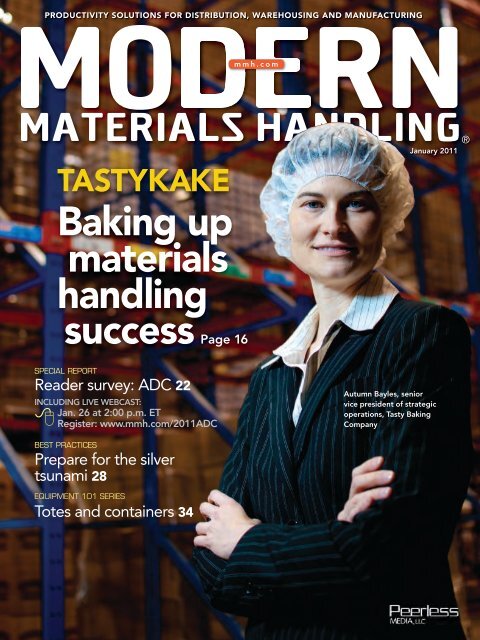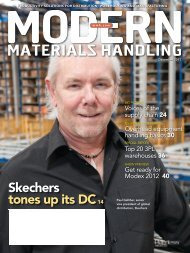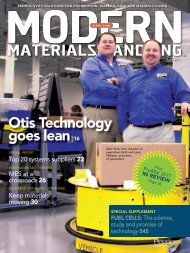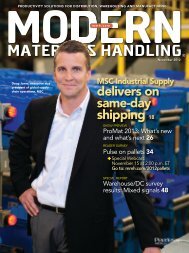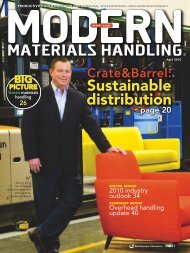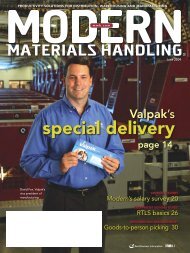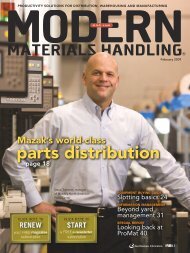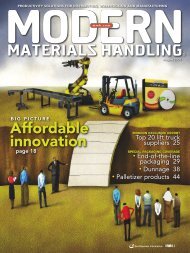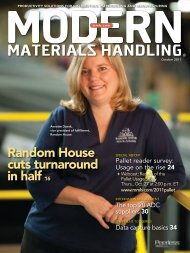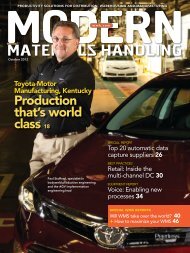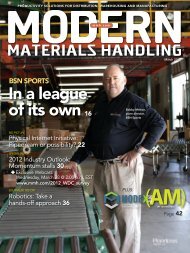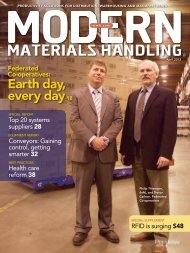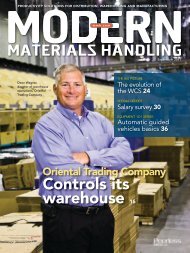Modern Materials Handling - January 2011
Modern Materials Handling - January 2011
Modern Materials Handling - January 2011
You also want an ePaper? Increase the reach of your titles
YUMPU automatically turns print PDFs into web optimized ePapers that Google loves.
CLICK HEREfor our “Workstation IntegrationSystem Evaluation White Paper”▲▲
COGNEX CORPORATION PRESENTS THE DATAMAN 500 BARCODE READERNOTHING LIKE THIS HAS EVER BEEN SEEN BEFOREIN AN IMAGE-BASED BARCODE READERFOR USE ON IMAGE-BASED BACKGROUND “HIGHER (eg, READ advert RATES – or READS brochure)THE BARCODESTHAT LASER SCANNERS CANNOT READ”“EASIER TO USE THAN A LASER SCANNER– YOU CAN SEE WHAT THE READER SEES”“NO MOVING PARTS – DESIGNED TO BEMORE RELIABLE THAN A LASER SCANNER”“SET TO DOMINATE CODE READING IN THE LOGISTICS,RETAIL DISTRIBUTION AND POSTAL MARKETS”GUEST STAR: IDMAX ® (The hottest barcode reading software known to man) FEATURING: HIGHEST READ RATES SUPPORTED BY: AUTO-FOCUS, AUTO-TRIGGER, AUTO-TRACKINTRODUCING: 1,000 FRAMES/SEC, SIMPLE TO USE, “NO READ” FEEDBACK and ETHERNET NETWORKING Includes the hit songs: “The Power of Sight” and “Can’t Live with Just a Line of Light”NOW ON GENERAL RELEASELimited Time Offer – FREE 30 Day Trial. Apply now atwww.thelaserkiller.com*Subject to applicable terms
EDITORIAL OFFICES111 111 Speen Street, Suite Suite 200 200Framingham, MA MA 01701-1496(800) 375-8015Michael LevansGROUP GROUP EDITORIAL EDITORIAL DIRECTOR DIRECTORmlevans@ehpub.comBob Bob TrebilcockEXECUTIVE EXECUTIVE EDITOR EDITORrobert.trebilcock@myfairpoint.netNoël P. P. BodenburgEXECUTIVE EXECUTIVE MANAGING MANAGING EDITOR EDITORnbodenburg@ehpub.comLorie King King RogersASSOCIATE ASSOCIATE EDITOR EDITORlrogers@ehpub.comSara Sara Pearson SpecterEDITOR EDITOR AT AT LARGE LARGEsara@moxiemarketingllc.comRoberto MichelEDITOR EDITOR AT AT LARGE LARGErobertomichel@new.rr.comTom Jeff Andel BermanCOLUMNIST GROUP NEWS EDITORtandel4315@aol.comjberman@ehpub.comJeff Josh Berman BondGROUP CONTRIBUTING NEWS EDITOR EDITORjberman@ehpub.comturbobond@gmail.comJosh Mike Bond RoachCONTRIBUTING CREATIVE DIRECTOR EDITORturbobond@gmail.commroach@ehpub.comMike Wendy Roach DelCampoCREATIVE ART DIRECTOR DIRECTORmroach@ehpub.comwdelcampo@ehpub.comWendy Daniel DelCampo GuideraART ILLUSTRATION DIRECTORwdelcampo@ehpub.comdaniel@danielguidera.comDaniel Brian Ceraolo GuideraILLUSTRATION GROUP PUBLISHERdaniel@danielguidera.combceraolo@ehpub.comBrian CeraoloGROUP PUBLISHEREDITORIAL ADVISORY BOARDbceraolo@ehpub.comRon GiuntiniEDITORIAL OEM PRODUCT-SERVICES ADVISORY INSTITUTE BOARDRon GiuntiniOEM John PRODUCT-SERVICES HillINSTITUTEESYNCJohn TRANSYSTEMS HillESYNCTRANSYSTEMS Susan RiderRIDER & ASSOCIATESSusan RiderRIDER Ken & Ruehrdanz ASSOCIATESDEMATICKen RuehrdanzDEMATIC Dr. John UsherUNIVERSITY OF LOUISVILLEDr. John UsherUNIVERSITY Col. Alan OF B. LOUISVILLE Will2D MARINE LOGISTICS GROUPCol. Alan B. Will2D Brett MARINE Wood LOGISTICS GROUPTOYOTA MATERIAL HANDLING USABrett WoodTOYOTA Peerless MATERIAL Media, HANDLING LLC USAA DIVISION OF EH PUBLISHING, INC.PeerlessKennethMedia,MoyesLLCA DIVISION OF EH PUBLISHING, INC.PRESIDENT AND CEOKenneth EH PUBLISHING, Moyes INC.PRESIDENT AND CEOEH Brian PUBLISHING, Ceraolo INC.PUBLISHER ANDBrian EXECUTIVE Ceraolo VICE PRESIDENTPUBLISHER PEERLESS MEDIA, AND LLCEXECUTIVE VICE PRESIDENTPEERLESS MAGAZINE MEDIA, SUBSCRIPTIONSLLCStart, renew or update your FREEMAGAZINE magazine subscription SUBSCRIPTIONS atStart, www.mmh.com/subscribe.renew or update your FREEmagazine Contact customer subscription service at at:www.mmh.com/subscribe.Web: www.mmh.com/subscribeContact Email: customer mmhsubs@ehpub.comservice at:Web: Phone: www.mmh.com/subscribe1-800-315-1578Email: Mail: mmhsubs@ehpub.comPeerless MediaPhone: 1-800-315-1578P.O. Box 1496Mail: Peerless Framingham, Media MA 01701P.O. Box 1496eNEWSLETTER Framingham, SUBSCRIPTIONSMA 01701Sign up or manage your FREEeNEWSLETTER eNewsletter subscriptions SUBSCRIPTIONS atSign www.mmh.com/enewsletters.up or manage your FREEeNewsletter subscriptions atwww.mmh.com/enewsletters.®MemberMember ofTHIS MONTH IN MODERNWinnerJesse H. NealCertificates of Meritfor JournalisticExcellenceMICHAEL LEVANSGROUP EDITORIALDIRECTORCommitting to sustainable growthHaving lived in New England thepast 20 years, I applaud those whohold storied structures—like FenwayPark—near and dear to their hearts. But,I also understand that there comes a timewhen organizations need to step away fromtraditional structures—when somethingiconic has simply outlived its usefulness.All too often the future of an organizationrests on such difficult decisions. And for theTasty Baking Company, the makers of thepopular Tastykake line of products based inPhiladelphia, that time came three years ago.The company was baking the bulk of itsproducts at is flagship facility that was builtin 1920; however, over the past decade thebeloved structure was beginning to bust atthe seams. According to Autumn Bayles,the company’s senior vice president of strategicoperations, the multi-storied buildingwas becoming too difficult to maintain. Butof more concern to its logistics operation,they had outgrown the warehouse andshipping area and were being forced to usea building around the corner to handle theoverflow.This led to too much double handlingand ultimately pushed the managementteam to the drawing board. The impressiveresult unfolds on page 16. Executive editorBob Trebilcock takes us inside Tasty Baking’snew 345,0000-square-foot facility that includes100,000 square feet of state-of-theartwarehouse space that adjoins the bakeryarea—enough room to consolidate storageand picking under one roof.What I find most interesting is that thenew facility allows Tasty Baking to realizebenefits outside the four walls. Notonly does the new, high-velocity pickingenvironment lessen the strain on logisticsoperations and prepare the company forfuture growth, but the building itself worksto solidify the company’s commitment tosustainability as well as its hometown.Even though ample space opportunitiesexisted outside the city limits, the companychose to set up shop in an abandonedindustrial site in the Philadelphia Naval Yardto stay true to its city roots. According toTrebilcock, “Tasty Baking was able to repurposethe original buildings as foundationmaterial for the new bakery, which avoidedclearing a forest and reduced constructionwaste.”The company then set its sites onachieving LEED-Silver certification in therenovation components, including a white,reflective roof to minimize heat-absorbingsurfaces; paints and carpet with low chemicalcontent; and environmentally friendlyrefrigerants, just to name a few.“They’ve streamlined operations andensured the customers receive the freshestproduct as fast as possible,” says Treblilcock.“And when you factor in the technologyadvancements being put to use toimprove employee productivity, coupledwith their commitment to community andsustainable construction, this is a transformationstory that truly stands out amongstthe rest.”Official Publication ofmmh.com MODERN MATERIALS HANDLING / JANUARY <strong>2011</strong> 7
SAVE.A TON.The world’s lightest multi-use pallet is a heavyweight when it comes to putting moneyon the bottom line. Saving as much as $2 per unitized load, it’s in a class by itself.Thanks to lower transport costs, more product per pallet, less production downtimeand fewer returned loads, it all adds up to a ton of savings. Now that’s heavy.Making the switch to iGPS is simple and fast, and the savings start right away.Learn how to ship out and cash in by calling 800-884-0225 or visiting igps.net©iGPS 2010
Di@blogbest of <strong>Modern</strong>’s blogsCompany Briefings | Bob TrebilcockA year in review | mmh.com/article/saying_goodbye_to_2010PACKAGINGPallet trends to watch in <strong>2011</strong>WHAT ARE THE MOST IMPORTANT ISSUES FACING THE PALLETINDUSTRY IN <strong>2011</strong> THAT MIGHT ALSO AFFECT PALLET USERS?BY BOB TREBILCOCK, EXECUTIVE EDITORWHAT IS THE PALLET INDUSTRYWATCHING? To find out, <strong>Modern</strong>talked to Chaille Brindley, publisherof Pallet Enterprise, the leadingtrade publication covering the palletindustry. Brindley also publisheswww.palletprofile.com and www.recyclerecord.com.Brindley identified three storieshe’s going to be following next year.A new pallet mandatefrom CostcoLast August, Costco released an addendumto its structural packagingspecifications. Starting in <strong>January</strong> <strong>2011</strong>,the club store will no longer accept48 x 40 inch GMA stringer or runnerstylepallets at its distribution centers.Instead, suppliers are required to shiptheir products on 48 x 40 inch blockpallets. The club store will accept shipmentson rental pallets from CHEP.“Equivalent one-way block palletsthat are a better value than rentingfrom iGPS, PECO and CHEP,” saysCostco, are also acceptable under thenew specs. Those pallets must be theequivalent of a PECO or CHEP palletbased on a detailed report using thepallet design system from the Nationalmmh.com MODERN MATERIALS HANDLING / JANUARY <strong>2011</strong> 9
all settles out, I wouldn’t be surprisedif you get a call from CHEP down theroad,” Brindley says. “And before nextyear is out, I wouldn’t be surprised ifwe see pallet prices go up and a shortageof cores in the used pallet marketin some parts of the country. Actually,we are already starting to see tightcore supplies in some markets.”Food safety anddrug recallsThe most visible pallet story of 2010was the recalls by Johnson & Johnsonand Pfizer of product allegedto have been contaminated by thechemical, 2,4,6-tribromoanisole(TBA), which can result from thebreakdown of another chemicalcalled 2,4,6-tribromophenol (TBP)when a treated pallet becomes wetand releases a moldy, musty smell.Although TBP is banned in theUnited States, it is used as a fungicideto treat transport packagingmaterials, including pallets, in someSouth American and Caribbean countries.In the case of J&J and Pfizer,the allegedly contaminated productoriginated in Puerto Rico.Why this is an important story? “Ithink it’s a made-up crisis chasing areal issue,” says Brindley. “It’s madeup because whatever happened hasnothing to do with pallets manufacturedin the United States. Whetherpallets are at fault or not, whateverhappened with the recalls had to dowith off-shore manufacturing and differentstandards for treating wood inthe Caribbean than the standards inthe United States.”At the same time, Brindley acknowledgesthat the issue has put aspotlight on pallets in the purchasingdepartments of pharmaceuticaland consumer packaged goodscompanies, and not necessarily forthe better. “It’s good in that peoplehave pallets on their radar screen,”he says. “Too many people look at apallet as a pallet and now they realizethat’s not always the case. But it hasalso caused a lot of worry in the marketplace.End users need to realizethis is a sanitation and storage issueand not a pallet issue.”What is the impact on pallet users?“Pallets need a little bit of respect,”says Brindley. “Pallet users need torealize that a pallet can go anywhere.You have to think about climate andregulatory issues.”Brindley advises pallet users totalk to their pallet suppliers abouthow they intend to use their pallets,and pallet suppliers need to be thinkingabout how to treat their palletsif they’re going into an environmentwhere wood pests, internationalregulations, mold or sanitation canbe an issue.INTRODUCING!TRI•DEX Label Holders forSlotted Plastic BinsLOCKS INTO PLACE - NO ADHESIVE BACKING REQUIRED!SIMPLY PRINT YOUR LABEL, INSERT IT INTO THETRI•DEX HOLDER AND SLIDE INTO THE BIN SLOT!• 5 POPULAR SIZES - FITS MAJOR MANUFACTURERS STANDARD BIN SLOTS• BAR CODE PROTECTION • LASER INSERTS INCLUDEDSee Us At...Check Out Our Tri•Dex Label HoldersPlus Our Entire Product Line atPROMAT <strong>2011</strong> onMarch 21-24, BOOTH #1914218 MacArthur AvenueNew Windsor, NY 125531•800•242•3919www.aignerindex.commmh.com MODERN MATERIALS HANDLING / JANUARY <strong>2011</strong> 11
log@wayExcerpts from executive editor Bob Trebilcock’s bloggo to... www.mmh.com for complete postsThinking beyond labor to justifyautomationOver the years, the reduction of headcount has been the way companiesjustified an investment in automation.While getting rid of labor is stillthe most common metric used inthe return on investment calculation,one of the emerging trends I cameacross reporting an upcoming storyon materials handling automation isthat some companies are thinkingbeyond labor to justify automation.Or, they’re thinking beyond simplyreducing labor to justify their investments...Supply chain software and theinnovation economyOne of the things we hear often inthis recession is that small business isthe engine for jobs and the source ofinnovation. Last week, I came acrossSG Software Group, a small supplychain software company in Sandwich,Mass., that is an example of both.Well, sort of.First, the sort of—the jobs part.The company was founded by agroup of guys—the SG stands forSome Guys—who have lots of experiencein logistics, distribution andsupply chain software and who haveeither worked together as colleaguesON-DEMANDor were clients of one another. For instanceJim Fox, the company’s CEO,has worked for Roadway, AmericanSoftware and Voxware; Mark Lania,the vice president of sales, workedfor Kewill; and Warren Engard, thevice president of product strategy,worked in operations at Dunkin’Donuts. You see the connection...RFID innovationIn November, I published an updateon RFID in the supply chain. To me,the most important takeaway is thatindustry continues to find new waysto get value from the technology,largely under the radar.A couple of weeks ago, I talked toAlastair McArthur, the chief technologyofficer for Tagsys, about a new solutionit created for Qantas Airlines.In this case, Tagsys has developeda rewritable passive tag thatis part of a system to speed passengersthrough the check-in andbaggage-drop process. Insteadof logging in at a kiosk and thenstanding in line to drop off a bag atsecurity, a passenger will be issueda smart card that they can use tolog in to the kiosk. Separately, eachpiece of luggage will get a permanentRFID tag that stays with a bagas long as it’s in use...InnovativeWarehouseSolutionsFeatured Webcasts on-demand@www.mmh.com2010 Warehouse & DC Operations Benchmark StudyInventory turns have increased, more expansions are on the books, and incentiveprograms are finally being dusted off. Things are finally looking up. In fact, the resultsof the Supply Chain Group’s 5th Annual Warehouse & Distribution CenterOperations Survey are showing clear signs of recovery.Listen to the Webcast on-demand at:mmh.com/article/2010_warehouse_dc_benchmark_studywww.interlakemecalux.com1-(877)-MECALUX
lift truck TIPSElectric trucks: Managing the juiceA power study will tell if electricmakes sense for your operation.By Josh Bond, Contributing EditorFans of electric and internal combustion(IC) lift trucks often find themselves onopposite sides of a Red Sox/Yankeesstylerivalry, with outspoken champions andstaunch critics residing in each camp. Whilethis column is not likely to result in manyconverts either way, it should be noted thatelectric lift trucks have continued to gain significantmarket share over recent years. Withthis in mind, <strong>Modern</strong> recently spoke withrepresentatives from the NAACO <strong>Materials</strong><strong>Handling</strong> Group for their thoughts on whatedge, if any, electric lift trucks might have.David McNeill, manager of productstrategy for Class I electric lift trucks for NMHG, says thenumber of electric lift trucks in service began surpassingits IC counterpart about 15 years ago. “At that time, itwas about 50/50,” says McNeill. “Now 61% of lift trucksare electric.”That growth is driven by the potential for multifacetedsavings, says McNeill. Fewer emissions reduce the needfor air turnover inside indoor facilities, creating energysavings. Fewer moving parts in electric lift trucks meanless maintenance costs over the life of the truck. And, at10 cents per kilowatt-hour, electricity costs about $150per month per truck, as opposed to as much as $600 permonth for liquid propane, according to McNeill.McNeill recommends a power study at the outset ofany potential fleet reconfiguration. If it’s determined thatelectric is a good fit, Lou Micheletto, manager of warehouseproduct strategy for NMHG says there are a fewways to enhance the lifespan and efficiency of electric lifttrucks. Tires with a low friction coefficient might increaseefficiency, while modern quick-charge or opportunitychargetechnology can sustain uptime and replace theneed for multimillion-dollar battery rooms.That said, there are still a few reasons why manychoose not to pursue an electric lift truck fleet. “Peoplehave always recognized the benefits of electric,” says Micheletto.“But the problem has always been the disciplinerequired to manage electric trucks. When an IC truckruns out of propane in the middle of a shift, I can go getanother can, and I’m back up and running. But I can’t geta can of watts.”While managers are considering the increased disciplinerequired of an electric fleet, Micheletto suggeststhat electronic lift truck components might also lead tofurther efficiencies in warehouse management. Truckmountedaccelerometers can track and reduce shrinkageand equipment damage by increasing accountability, saysMicheletto. “Trucks are designed not to run into things,but to lift things,” he says. “And whenever a truck doeshit something, ‘I Don’t Know’ is the guy who did it.”The same culprit is usually responsible when an electriclift truck overheats and powers down due to excessivestrain. With truck-mounted monitoring equipment, undesirableincidents such as collisions or overworked trucksare tied to individual operators. The data can be usedto educate against recurrences, allowing managers toprevent, monitor and remediate such events.“If you teach operators how to avoid the negative andshow them you are tracking the negative, then the negativehas a tendency to disappear,” says Micheletto.Josh Bond is a contributing editor to <strong>Modern</strong> and can bereached at josh.d.bond@gmail.com.14 J anuary <strong>2011</strong> / <strong>Modern</strong> <strong>Materials</strong> <strong>Handling</strong> mmh.com
Warehouse Labels & SignsWAREHOUSE SIGNSSolutions for all your bulk storage identificationneeds for indoor or outdoor applications.• Long-range retro reflective• Flat, bent or two-sided Z shapedsign fabrication• Dock door• Aisle• BullsEye oval floor platesRACK LABELSDurable polyester rack labels help insureconsistent bin location year after year. We produceand install over 5 million rack labels annually.• Horizontal and vertical upright• Magnetic• Protective laminates standard• Special adhesives — cover up andfreezer applications• Color coding for tier identification anddirectional arrow graphic imagesPREPRINTED LPN LABELSPreprinted barcode pallet id labels save significanttime and money compared to print-on-demandthermal transfer.• Run and hold inventory programs• Same day shipping• 2-D and linear barcodes• Corner-wrapNATIONALINSTALLATION SERVICESThe most comprehensive installation servicesin the industry. With over 40 years ofcombined experience, our installation teamprovides nationwide coverage that deliversgreat value, guaranteed quality and on-timeengineered solutions.• Customized installation solutions• Data file manipulation• Fully bonded and insuredFREE white paperon the benefits of preprintedlabels VS. print-on-demandCALL TODAY!FREE samples available.Channel partner inquiries welcome.salesmmh@idlabelinc.comToll-free: 800.541.8506 x100www.idlabelinc.comPositive feedback...Every timeID LABEL INC.425 Park AvenueLake Villa, Illinois 60046
Baking up16 J ANUARY <strong>2011</strong> / MODERN MATERIALS HANDLING mmh.com
MODERN system reportmaterialshandling successVoice recognition technology is speeding fresh-bakedgoods through Tastykake’s new state-of-the-artbakery in Philadelphia.By Bob Trebilcock, Executive EditorFor more than 80 years,the bulk of the apple pies,Butterscotch Krimpets andPeanut Butter Kandy Kakesthat made Tastykake ahousehold name in Philadelphia werebaked in a flagship bakery built in the1920s by the Tasty Baking Company.Like many iconic structures, it hadoutlived its usefulness. “It was a multistorybuilding that was hard to maneuveraround and hard to maintain,” saysAutumn Bayles, senior vice presidentof strategic operations. “We had alsooutgrown the warehousing and shippingarea and had to use another buildingaround the corner. That led to a lotof double handling of product.”The solution was a state-of-the-art,Voice recognition speeds bakeryfreshtreats to customers at TastyBaking’s new state-of-the-art bakery.Terry Sabler, director of distribution(left) and Autumn Bayles, senior vicepresident of strategic operations(right) oversee distribution.PHOTOGRAPHY BY JEFF FUSCOmmh.com MODERN MATERIALS HANDLING / JANUARY <strong>2011</strong> 17
modern system report345,000-square-foot bakery, including100,000 square feet of warehousespace, which opened for business inthe summer of 2010. The overall facilitywas designed with sustainabilityin mind, including several featurestargeting LEED-Silver certificationfrom the Leadership in Energy andEnvironmental Design initiative.When it came to distribution, TastyBaking Company implemented processesand technologies to accuratelyspeed inventory through the facility.“We’re shipping fresh baked goods,which means we keep an average ofone and a half days of inventory in thewarehouse,” says Bayles. “Most of ourcustomers get a shipment every day.”The 100,000-square-foot facility hasjust 2,000 pallet positions in a fourlevelstorage area plus a small freezerspace. The system relies on voiceenabledputaway and picking processes(Lucas Systems, www.lucasware.com)to synchronize picking activities withdelivery truck departure schedules.The result is a high-velocity pickingenvironment that has streamlinedoperations and ensures thatcustomers receive the freshest productpossible.Fresh-baked goods are palletized and stretchwrapped at the end of thebakery (top) before being picked up for delivery to the warehouse.Designing for sustainable growthThe Tasty Baking Company wasfounded in 1914 when a baker fromPittsburgh and an egg salesmanfrom Boston went into business inPhiladelphia to produce baked goodsusing the best ingredients they couldfind delivered fresh daily to the bakery.According to company history, theproducts were so good that the wifeof one of the founders said they were“tasty,” hence the Tastykake phrasefor the bakery’s products. At 10 centsa cake, the pair sold $222 worth ofproduct the first week and $300,000 ingross sales by the end of the first year.Today, gross annual sales are in excessof $280 million.The flagship bakery was built in the1920s in Philadelphia. By the 1930s,the company had expanded its productline to include Butterscotch Krimpetsand cupcakes, and individually pack-18 J anuary <strong>2011</strong> / <strong>Modern</strong> <strong>Materials</strong> <strong>Handling</strong> mmh.com
aged lunchbox-sized pies, a revolutionaryconcept at the time.Over the years, the companyexpanded its operations, including afacility in Oxford, Pa. Still, it outgrewits capacity in Philadelphia. “In our oldfacility, we picked from a sea of palletson the floor,” says Terry Salber, directorof distribution. “Since we were usinga paper-based picking system, it tooka lot of time to train people to identifyall the different stock keeping units(SKUs) and where they were located.We knew we needed a new method tosimplify picking and training.”In addition, relying on floor stagingfor picking meant the company had tolease another nearby space for temporarystorage. “In our old system, wepalletized product as it came off theline, but then shipped it to a nearbycenter and brought it back for picking,”says Bayles. “That led to a lot ofdouble handling.”In May 2007, Tasty Bakingannounced plans to build a new345,000-square-foot facility thatincluded 100,000 square feet of warehousespace adjoining the bakeryarea—enough space to consolidatestorage and picking under one roof.In addition to efficient materialshandling and order fulfillment, therewere other priorities in both the siteselection and design of the new facility.For one, the company felt a commitmentto keeping Philadelphia agreat place to live and work, which wasone of the deciding factors in choosingan abandoned industrial site inthe Philadelphia Naval Yard. The bakerywas able to repurpose the originalbuildings as foundation material for thenew bakery, which avoided clearing aforest and reduced construction waste.Second, the bakery was built withseveral features to target LEED-Silvercertification including:• A white, reflective roof, which minimizesheat-absorbing surfaces thatcontribute to global warming.• No-mow, drought-resistant grass thatuses less water.• All wood doors. And, half of thewood used in the building comesPutaway in the rack system is voice directed. Pallets are stored on the top twolevels of the rack system while floor-level positions are reserved for pickingand order fulfillment.from certified sustainable sourcesthat work to conserve trees.• Paints and carpeting with low chemicalcontent that reduce ear, nose andthroat irritation.• Refrigeration equipment that usesenvironmentally friendly refrigerantsto minimize emissions that contributeto global warming.• Covered parking lot lights that reducelight pollution; bike racks and accessto public transportation that reducevehicle usage and pollution.• Solar panels on the roof to providepower to several of the building’s systems.The company has also obtaineda grant to install solar panels on theroof of the distribution center.Optimized voicePutting in a new warehouse createdan opportunity to rethink storage andmmh.com <strong>Modern</strong> <strong>Materials</strong> <strong>Handling</strong> / <strong>January</strong> <strong>2011</strong> 19
modern system reportto ensure freshness, product stays in the warehouse for a short period of time before it’spicked to a pallet and staged for delivery to customers by route trucks.distribution processes by bringing bothtogether under one roof. The over-ridingstrategy was to create a flexible andsimple system that emphasized speed.“We use a demand-driven modelhere,” says Bayles. “Pies are almost abake-to-order item: We’re putting theminto the racks as our associates arepicking them. The rest of our productsare bake-to-inventory, but we maintaina very lean inventory.”In addition to space limitations,operating a paper-based picking systemhad limitations. “We use the warehousemanagement modules in our enterpriseresource planning system to managethe warehouse,” says Salber. “A largeorder could be five or six pages long. Ifa picker was not paying attention, hecould easily skip a page.”Several different technologies andpicking methodologies were considered.For instance, a pick-to-light solutionwould have been more accuratethan paper-based picking, “but conveyorand sortation did not work wellbased on the velocity at which ourinventory turns,” Salber says.A radio frequency-enabled bar codescanning solution was also ruled outbecause of the amount of time requiredfor training. That led to voice technology.“When we were evaluating differenttechnologies, I noticed that companiesusing voice were able to bring ona new employee and have them out onthe floor and productive in a couple ofdays at most,” says Salber. “It also madesense to have hands-free picking withvoice.”Ultimately, Tasty Baking installed afour-level pallet storage area. Pallets arebuilt and shrinkwrapped in the bakery.The warehouse management systemgenerates a bar code label that is usedfor inventory management, but also forlot and batch traceabilityin the case of a recall.Pallets are then putawayon levels 2-4 in the palletstorage area. The floorlevel is reserved for picking.Next, the system wasoptimized to build palletsbased on the departureschedule for the bakery’strucks. “When we send thework from SAP to the voicesystem, we know whichtrucks we want to loadfirst and then we build andstage the pallets accordingly,”says Salber. “Thatrequired some programminglogic and enhancedintegration, but it’s been agreat improvement.”After just six months ofrunning a voice-enabledfacility, Salber says theyare running a much fasterwarehouse. “We had a lotof overtime in the old facility,in part because we hadto bring product over from around thecorner,” she says. “We also have moreaccurate inventory with voice than in thepast because our putaway and pickingprocesses are more precise.”In addition, the voice systemincludes metrics to measure how efficientlyoperations are working; in thepast, that had to be done with spreadsheets.The next step, she adds, will be topick two orders at a time, since thefacility is using double pallet handlingjacks. And, instead of stagingpallets for delivery, the next step is toload a completed pallet into a truckimmediately.“This was one of the last steps in thetransformation of our company,” saysBayles. “We replaced a piece of theheart of the company with somethingthat was modern and will take us to thenext level.” M20 J anuary <strong>2011</strong> / <strong>Modern</strong> <strong>Materials</strong> <strong>Handling</strong> mmh.com
Sweet sound of successVoice takes a traditional warehouse to the next level.Getting freshly baked productout the door is paramount forthe Tasty Baking Company. Forthat reason, the ability to accurately andquickly fill orders that are optimized forroute delivery was a key priority in thedesign of its new warehouse.receiving and putaway: At the end ofthe manufacturing line in the bakery,freshly baked products are packaged,palletized and shrinkwrapped . At thatpoint, an associate prints and applies abar code label onto the shrink wrap andscans the label to enter the finishedproduct into Tasty Baking’s enterpriseresource planning system (ERP). Thewarehouse management module in theERP system determines a putaway locationin the pallet or freezer storage area. The associate then delivers the palletby lift truck to the right location inthe storage area and confirms the putawayby speaking a check digit into thevoice system. Product is stored on levelstwo through four of the four-level storagearea. The ground floor is used forpicking. Once confirmed, the product isavailable for delivery in the system.The bakery also receives productfrom other locations. In thoseinstances, product information ismanually entered into the ERP system,which receives the product against apurchase order. The system then generateslicense plate bar code labels thatare applied to the pallets and scanned.As with product received from the bakery,the system determines a putawaylocation in the pallet storage area ,which the associate confirms by speakinga check digit into the voice system.Once, confirmed, the product is alsoavailable for delivery in the system.Picking: To initiate the picking process,an order selector signs into thevoice system and indicates that he isready for work. Orders are createdin the ERP system based on demandand delivery schedules. The strategyis to synchronize the work on thewarehouse floor with truck departuretimes. If an order needs to be expedited,the system may divide up thework for that order among five or sixorder selectors who will build palletsfor that delivery. In either event, theTasty BakingCompanyPhiladelphia, Pa.size: 345,000 square feet, including100,000 square feet of warehouse spaceProducts: Cakes, pies, donuts andcookiestHrougHPut: 100,000 cases per weeksKus: 100sHifts: 2 shifts; 5 days per weekeMPloyees: 48 in warehouse operationsselector is directed by the voice systemto a picking location on the floor levelof the pallet storage area . Once hereads a check digit to confirm he is atthe right location, the system tells himhow many cartons to pick to a pallet.Once he confirms the pick, inventoryis automatically adjusted in real time.shipping: When the order selector tellsthe system that picks are complete,he is directed to deliver the pallet to astretch wrapping station and then toa staging area . When all of the palletsfor an order have been staged, thetruck is loaded and ready for departurefrom the shipping area . MStretchwrap area4Staging area 5Bakery 1Pallet storage andpicking area22Freezer storageand picking areaSystem suppliersVoice recognition system: LucasSystems, www.lucasware.comsystem design: OPSDesign Consulting,www.opsdesign.comPallet rack: Frazier Rack, www.frazier.comlift trucks: Crown, www.crown.comerP/WMs: SAP, www.sap.comBar code scanning: Motorola,www.motorola.comPackaging system: Thiele Technologies,www.thieletech.comPalletizer: FleetwoodGoldcoWyard,www.fgwa.com3Receiving and shippingmmh.com <strong>Modern</strong> <strong>Materials</strong> <strong>Handling</strong> / <strong>January</strong> <strong>2011</strong> 21
WEBCAST:Results of the <strong>2011</strong> Automatic Data Capture (ADC) User SurveyWednesday, <strong>January</strong> 26 @ 2:00 p.m. ET • Register: www.mmh.com/<strong>2011</strong>ADCent industry segments will grow from5.6% to 19.5% a year over the next fiveyears in our annual look at the Top 20automatic data capture suppliers inNovember 2010 (www.mmh.com/view/top20suppliers/mobile).To find out how <strong>Modern</strong> readers aredeploying ADC technologies, we surveyedemail subscribers of <strong>Modern</strong> aswell as a sample of recipients of oure-newsletters. We received responsesfrom 362 qualified responders, definedas a reader who is employed at a locationthat uses ADC technologies. Therespondents represented 12 differentindustries, from food manufacturingto wholesale distribution. They alsoskewed heavily toward manufacturing:• 39% report that they work at warehousing/distributioncenters,• 33% report that they work at manufacturingfacilities, and• 28% report that both manufacturingand warehousing take place at theirfacility.What’s more, nearly 76% of respondentsintend to invest in ADC technologyover the next 12 months. While64% of those said they will spend lessthan $100,000, 12% expect to spendmore than $500,000, including 14respondents who said they will spendmore than $1 million.Here’s what we learned across eachof the major ADC categories.What processes are enabled by bar code scanning?Putaway—manual processReceiving—unloading at the dockSource: Peerless Media Research GroupReceiving—stagingPicking—full palletPicking—caseConfirmation of truck loading/shippingPicking—split-case or piece pickingStaging—shipping dockReplenishmentPacking/palletizingRoute products via conveyor/sortation systemsPutaway—into automated storage systemsRecieving—gate/yard activitiesValue-added servicesBar code scanningIt’s been nearly 40 years since thefirst bar code scanning systems wereinstalled in industrial operations, butthe technology is now ubiquitous inmanufacturing and distribution centers,with 81% of respondents reportingthat they use or plan to use bar codescanning systems in their facilities.A majority are using both mobilehandheld scanners (88%) and fixedscanners (51%). But, our readersare also adopting wearable computingdevices for hands-free scanning,including wrist scanners (12%) and ringscanners (9%).We also found that bar code scanningis enabling virtually every process in afacility, from putaway (63%) to full pallet(51%), case (49%) and piece (47%) pickingto value-added services (21%).While the market for 2D bar codesthat carry more information than traditionalbar codes grew by 20% in 2009,relatively few readers have adopted thetechnology. Only 20% of respondentsare currently using 2D symbology andonly 18% said they are considering 2Dbar codes. Of those who are consideringthe technology, 60% want the abilityto put more information on a labelcompared to a traditional bar code. Theremainder said they want more accuracyin high-speed processing operations(26%) or are looking to the tags to complywith regulatory requirements (21%).21%29%29%28%52%51%49%49%47%46%44%41%57%63%In written comments, readers toldus they were considering 2D bar codesto protect their products against counterfeitingor because they complementhigh-speed conveyor and sortationoperations.Voice recognitionBased on many of the stories featuredon our cover, like this month’s featureon the Tasty Baking Company, voicehas been giving bar code scanning a runfor its money, particularly in case- andpiece-picking operations.Still, only a few of our respondents(12%) are currently using voice or consideringthe technology in their operations(14%). Seventy-four percent arenot using voice or considering usingvoice. That may be a reflection of thenumber of manufacturers in our survey,since voice has primarily been adoptedin distribution center processes.mmh.com <strong>Modern</strong> <strong>Materials</strong> <strong>Handling</strong> / <strong>January</strong> <strong>2011</strong> 23
If global warming doesn’t reduce your energycosts this winter, perhaps we can help.Introducing the newSmartSense365 !Big Ass Fans have always saved money in the winter,but now it can be done with the push of a button.The patent pending SmartSense365 keeps your space atthe perfect temperature year-round from floor to ceiling.SmartSense365 calculates the floor-to-ceiling temperaturedifferential and modulates the fan’s speed so youdon’t have to.NEWBottom line: you could save up to 30% on your heating billsBottom line: you could save up to 30% on your heating billsthis winter… and next winter… and next winter…Visit www.BigAssFans.com or call877-BIG FANS (877-244-3267) to learn more.An ISO 9001:2008 certified company.Covered by one or more of the following U.S. Patents: 6,244,821; 6,589,016; 6,817,835; 6,939,108; 7,252,478; 7,284,960; 7,654,798; D587,799; D607,988 and other patents pending.10 year parts, 1 year labor warranty; certain exclusions apply. See complete warranty for details. © 2010 Delta T Corporation dba the Big Ass Fan Company. All rights reserved.*
The company has also implemented a wirelessscanner that allows the forklift operator to scan theflat laser blank when it arrives, instantly assigningmaterials for each job number an initial weight.This job can now be tracked on the company’s computersystem throughout processing: allowing managersto keep a running total of the materials usedat all times.This electronic documentation keeps employeesup-to-date on each job—a significant advantage atthe company, where at any moment 250 productionparts may be rolling out the door.“This system allows us to know how much ourmaterials weigh, instantly record the weight, andknow in which processing stage each work order isat all times—so we know when the work order willbe done,” Hassen adds. “Keeping track of these jobsthroughout our three-building manufacturing facilitysaves us significant time while helping us maintainaccurate records.”On-DemanD PackagingGlobal manufacturer of lightweight tables and chairs uses on-demandpackaging system to deliver custom boxes and cost savings.By lorie King rogers, Associate EditorMity-Lite of Orem, Utah, takes the business ofsitting down very seriously. That’s because it’sa leading manufacturer of lightweight chairs andtables. So, when the company looked to improveefficiencies, every method and tool was evaluatedagainst three key operational drivers: quality, deliveryand cost.To help achieve its primary goal of providingaccurate, complete and on-time shipments to customers,Mity-Lite installed an on-demand packagingsystem (Packsize, www.packsize.com) to streamlinethe way tables are packaged for shipping.Before installing the new system, Mity-Lite’svast product offering forced the company to stockmore than 45 box sizes. “Planning for packagingneeds was difficult,” says chief operations officerBrian Bowers. “Our corrugated stock inventory tookup significant warehouse space, and we often foundourselves with too much inventory of slow-movingboxes and frequent stockouts in other sizes.”The new system builds exactly what’s neededwhen it’s needed. Selecting from three sizes ofcorrugate, an associate selects and enters the sizeand number of boxes needed into the machine’skeypad. The machine cuts the cardboard to size,complete with score lines and a glue tab. Theflattened box is delivered onto an out-feed table.Another associate inserts the box into an automatedgluer. The tables are then inserted into thecustom boxes, closed and staged for shipment.“With the switch from purchasing and storingfinished boxes to building boxes on-demand, wehave enjoyed several layers of operational improvementand cost reduction,” explains Bowers.Customized boxes have eliminated genericboxes that sometimes required alterations, andthe footprint for the company’s corrugated stockinventory has been reduced by 60%.The implementation of the on-demand packagingsystem was an important component in thecompany’s overall operations strategy, and accordingto Bowers, continues to support Mity-Lite’sadvancements toward a one-piece work flow. Mmmh.com <strong>Modern</strong> <strong>Materials</strong> <strong>Handling</strong> / <strong>January</strong> <strong>2011</strong> 27
MODERN best practicesERGONOMICS:Bracing for thesilver tsunami28 J ANUARY <strong>2011</strong> / MODERN MATERIALS HANDLING mmh.com
There’s a silver tsunami about to wash over the aging U.S.workforce, and the materials handling industry is directlyin its path. Here’s a look at our older workers and howergonomic solutions can keep them safe and productive.By Lorie King Rogers, Associate EditorThere’s a storm warning on the horizon, knownas the silver tsunami, that’s calling for lots ofgray… gray hair, that is. That’s because thewave of Baby Boomers, about 75 million of usborn between 1946 and 1964 who account for29% of the U.S. population, are getting older.And while some are heading off to retirement,many are remaining in the workforce.“Sixty-two is no longer the stepping offpoint,” says Brian McNamara, president ofSouthworth (www.southworthproducts.com).He’s right. According to the AARP, 69% ofBoomers plan to stay on the job beyond theage of 65.Boomers are pushing off retirement for goodreasons; we like our jobs, we’re still healthy, andwe like the social networking. In some cases,however, finances are the reason for stayingbecause investments aren’t worth what theywere before the economic downturn.Whatever the reason, this workforce trendis expected to continue. In fact, the Bureauof Labor Statistics predicts that the percentageof workers between the ages of 65 to 74mmh.com MODERN MATERIALS HANDLING / JANUARY <strong>2011</strong> 29
MODERN best practiceswill increase by 83.4% between 2006and 2016.Currently, the median age of awarehouse or distribution centerworker is between 47 and 50 yearsold. Ray Niemeyer, director of membershipfor the Material <strong>Handling</strong>Industry of America (MHIA, www.mhia.org), and managing executive ofMHIA’s Ergonomic Assist Systems andEquipment (EASE) Council, says hesees the materials handling workforcegoing from the 40- to 50-year-old rangeto the 50 to 60 range. As the workforceages, Niemeyer says, we need toembrace, respect and set the tone thatemployees are valued.Not only are older workers valued,they are in demand. Companies arefacing competition to retain the workersthey have, says Sean O’Farrell, businessdevelopment manager at Witron(www.witron.com). “[Workers] will lookbeyond pay rates and benefits to seewhich companies will make the workThe first thing to go…Here are a few of the most commonphysical conditions that change withage and some simple solutions tocombat the effects in the workplace.Eye sight: increase overall arealighting, install task lighting, providemagnifying devices, schedule frequentbreaks, use bright high-contrastmaterials for safety signage.Hearing: reduce backgroundnoise, enclose loud machinery, incorporatevisual cues, provide protectiveear equipment.Strength/force generation/flexibility: reduce the weight ofitems handled, rotate worker responsibilitiesto avoid repetitive strain.Mobility/balance: keep workareas free of clutter and trippinghazards.environment better for them physically,”O’Farrell says.Therefore, companies are investingin ergonomic solutions to keep olderworkers satisfied, safe and productive.These investments in the silver tsunamican be worth their weight in gold, saysDan Boos, principal of Boos ConsultingServices. He explains that it costs fourtimes as much to bring in a youngerworker than it does to retain a BabyBoomer. And, the intellectual capitalBoomers possess, along with companyloyalty and low turnover, is invaluable.“There are costs involved withchange,” agrees Ed Romaine, chief marketingofficer at Sapient Automation(www.getsapient.com). “But replacingworkers with the next generation ofemployee is another level of investment.Investing in ergonomic solutionsis a better bargain. You can spend lessand achieve more because the rightergonomic tools will yield a return oninvestment that makes it a win-win foreverybody,” Romaine adds.So where should a company invest?That depends. “There’s no such thing asa one size fits all workplace,” says JeffSmagacz, managing partner with theErgonomist Risk Management Group(www.riskgroup-llc.com). “What’s goodfor one portion of your population mightnot be a complete solution for yourentire worker population. But generally,if you design ergonomic solutions for thebroad spectrum—large males to smallfemales—you will capture about 90%of the work-related issues faced by olderworkers.”Plus, Smagacz adds, the cost differentialbetween a good ergonomic designand an excellent one is minimal.AwarenessExcellent design begins with awareness.“Look at the overall operation and ask:With flexible options, this workstationcan be raised or lowered to providea comfortable height while standingand an adjustable arm to position thecomputer screen at the optimum eyelevel.30 J ANUARY <strong>2011</strong> / MODERN MATERIALS HANDLING mmh.com
PRODUCTIVITY SOLUTIONS FOR DISTRIBUTION, WAREHOUSING AND MANUFACTURINGmmh.comThe Apparel Group:Dressed for distributionsuccess Page 18Kirk Longo, vice presidentof supply chain, TheApparel GroupSPECIAL REPORTTop 20 SCMproviders 26EQUIPMENT REPORTGreen unitizingpractices 30INFORMATION MANAGEMENTFive trends in WMS 34®July 2010Develop greaterbrand awareness andshowcase your featurededitorial from thisindustry-respectedpublication.Special corporateprofile issuePlace your press directly in thehands of your customers andprospects with custom reprints from<strong>Modern</strong> <strong>Materials</strong> <strong>Handling</strong> magazine.Event CollateralMedia KitsDirect MailOnline MarketingRecruiting Packages800.290.5460 x136 I mmh@theYGSgroup.comPresentationsThe YGS Group is the authorized provider of customreprint products from <strong>Modern</strong> <strong>Materials</strong> <strong>Handling</strong> magazine.
MODERN best practicesWhat are the stressors within the process?”recommends Sapient’s Romaine.The answer depends on the task.Examine the challenges of the job andthe ability of the worker. Make surethey are well matched. If there’s a disconnect,then ergonomic solutionscould bridge the gap.When a company looks at leanpractices throughout its organization,ergonomics has to be a big part of theoverall plan, says MHIA’s Niemeyer.“Ergonomic equipment like robotics,overhead handling devices, positioningequipment and handheld devices foreasier manipulation all play a role in acompany’s success.”Implementing this type of equipmentand creating an ergonomically friendlyworking environment should enable aperson to keep pace with expectationsor actually increase production andthroughput. Understanding physicalchanges that occur as employees agealso plays a role in overall success.Sight, sound and stepsSince older workers typically have lessthan 20/20 vision, paperless order pickingsystems like pick-to-voice and pickto-lightare worth looking into, saysThe Age Discrimination inEmployment Act of 1967Here’s a good question: How old is considered old?If you said 40, you’re elderly, according to thegovernment. The Age Discrimination in EmploymentAct of 1967 (ADEA), makes it illegal to discriminateagainst people 40 or older. Under the headingCongressional Statement of Findings and Purpose, itsays:“The Congress hereby finds and declares that:(4) the existence in industries affecting commerce,of arbitrary discrimination in employment because ofage, burdens commerce and the free flow of goods incommerce.(b) It is therefore the purpose of this chapter topromote employment of older persons based ontheir ability rather than age; to prohibit arbitrary agediscrimination in employment; to help employers andworkers find ways of meeting problems arising fromthe impact of age on employment.”Go to www.eeoc.gov/laws/statutes/adea.cfm toread more of the ADEA.Witron’s O’Farrell. These solutionscan reduce eye strain and preventpicking errors because it can behard to see and read a paper listaccurately.Hearing loss is about as commonas diminished eyesight.Charlie Zebell, vice president ofsupply chain solutions for SystemLogistics (www.systemlogistics.com), says while paperless pickingsolutions can be modified to uselarger screens and bigger, brighter typefor better viewing, the volume and tonecan also be adjusted for each worker.What’s more, he says, the headset willkick out background noise and make iteasier to hear and concentrate.But there’s another benefit at playhere, says Zebell, “The cost of technologyis going down, and companies areable to retain experienced, skilled workerswho have knowledge of the customerand knowledge of the products.”Providing ergonomic solutions is keyto employee retention and the creationof a worker-friendly environment.Another important step in creatingan ergonomically friendly workingenvironment is to reduce steps. This isespecially important for seniors sinceslips, trips and falls arethe most common workplaceinjuries for peopleover 65.“The goal is to avoidwalking and searchingfor products,” explainsSapient’s Romaine.With automated solutionslike horizontalcarousels and verticallift modules (VLMs),inventory is broughtto the operator anddelivered to them forprocessing at an idealheight, sometimescalled the golden zone.Romaine says someVLMs have featureslike tilt trays that makethe rear of the trayColorful, bold graphics displayed ona workstation monitor make it easyfor workers to see the products tobe selected and how to fill an orderaccurately.more accessible. This reduces the needto reach and stretch, which in turnreduces strain on the body.Lift assist and positioning devicesWorking within the so-called goldenzone can also be accomplished with liftassist and positioning devices that canraise a person to the product or productto the person. Either way, thesesolutions raise the level of safety in theworkplace.Lift assist devices are designed toeliminate bending to pick up parts,even if they only weigh 10 pounds.“That doesn’t sound heavy, but it’s therepetition that’s problematic,” saysSouthworth’s McNamara. “Any jobthat we would put under an area ofconcern is exacerbated by age. Whenwe start to think about why a job wouldrequire a younger worker, it’s probablyimproved through an assist device.”In addition to scissors lifts and docklevelers, pallet handlers are commonlyused in pallet loading and off-loadingand keep the work at a comfortableheight. According to McNamara, “Youshould be able to do the whole job rightat your belly button.”Overhead handlingSometimes the job requires overhead handling,and that’s where workstation cranescome into play. Over the years therehave been changes in standards, says JeffMcNeil, marketing manager at Gorbel32 J ANUARY <strong>2011</strong> / MODERN MATERIALS HANDLING mmh.com
modern Equipment 101: Totes and containersA primer for warehouse/DC managers34 J anuary <strong>2011</strong> / <strong>Modern</strong> <strong>Materials</strong> <strong>Handling</strong> mmh.com
Solving thepuz zledon’t take totes and containers for granted. theseseemingly simple products are key components in thematerials handling process, ensuring a smooth, efficientand safe flow of goods through the entire supply chain.By lorie King rogers, Associate EditorWhat’s made of plastic, has six sides and is brightly colored? If you said a Rubik’s Cube,you’re both right and wrong. If you said reusable plastic bins, totes and containers, you’re right.Unlike the puzzling toy, bins, totes and containers offer clear solutions.Available in hundreds of sizes and configurations—and found throughout the supply chain—reusable plastic bins, totes and containers bring many benefits to the materials handling table.From reducing packaging waste, to maximizing product protection, to optimizing inventorymanagement through standardization, returnable boxes generate dramatic cost and efficiencyreturns. But with so many choices, how do you choose?Before you answer that question, Joe Borer, marketing manager for Buckhorn (www.buckhorninc.com)says you will need to ensure a good closed loop system. “First and foremost, you have tomake sure you can get the containers back. If you can’t, you won’t realize the cost savings.”With your closed loop system in place, you carefully consider which returnable you need. “Askyourself the proper questions for the proper container recommendation,” says Nathan Franck, newmmh.com <strong>Modern</strong> <strong>Materials</strong> <strong>Handling</strong> / <strong>January</strong> <strong>2011</strong> 35
Manufacturing and assemblyTotes, bins and containers are all incorporatedin manufacturing and assemblyoperations. Small parts for assembly areorganized in bins captive to the facility.Totes storing work-in-process are alsocaptive as they travel through differentworkstations.Internal totes tend to stack and nest.Efficiency comes from being able to stackthem when full or condense them whenempty. These totes, often with footprintsof 24 x 16 inches or 20 x 12 inches in avariety of heights, are sized to productshape and weight considerations.Non-captive totes and containersmake the rounds in a closed loop system—truckedfrom a supplier’s facilityfull of components and arriving just-intimeto the assembly line.The majority of totes are straight wallstyle and modularly designed so thatwhen they are fitted together, the smallerfootprints combine to form a unit loadequivalent to the standard pallet footprint.The load is typically topped with acap and secured to prevent shifting.Similarly, larger containers carrylarger parts and stack together for transport.Because the standard footprintsare so established, users generally havea choice of off-the-shelf totes and containersfrom a variety of suppliers.Customized dunnage is often usedto protect the contents. When emptied,the dunnage stays inside the container,also eliminating the need to collapse.“Reusable packaging supports manyISO-certified and six sigma operationsby protecting incoming parts and outgoingproducts from damage,” saysOrbis’ Kukuk. “Expensive componentsand finished products are safe in heavyduty,durable plastic containers withcustomized interiors that protect delicateassemblies from damage.”For closed loop systems betweenmanufacturing operations, maximizmodernEquipment 101: Totes and containersproduct development manager for RehrigPacific (www.rehrigpacific.com). Forexample: What’s the use temperaturerange? Is a lid needed? Will the containerinteract with automation? How long doyou need the container to last?“Study all of your handling needs,and get input from someone experiencedin the field,” Borer says. “Theycan point out contributing factors thatwill help you make the right decision.”Figuring out what’s right startsTote and container supplierswith product protection, says NormKukuk, vice president of marketing atOrbis (www.orbiscorporation.com). Toget product safely from one point toanother, you have to understand what’srequired of the product from the timeit’s manufactured to when it reaches itsultimate destination. “Considerationsinclude product protection, parts percontainer, trip distance, supply chainvelocity and proximity to destination,ergonomics, airflow, materials handlingCompany Web site Phone numberAkro-Mils www.akro-mils.com 800-253-2467Amatech www.amatechinc.com 614-252-2506Atlas Material <strong>Handling</strong> www.atlasmh.com 847-678-3450Buckhorn www.buckhorninc.com 800-543-4454Carico Cowin www.caricocowin.com 800-466-6738C.R. Daniels www.dandux.com 800-933-2638Decade Products www.decadeproducts.com 877-999-6229Diversi-Plast Products www.diversi-plast.com 800-828-6114Endural www.endural.com 800-854-0553Flexcon Container www.flexcontainer.com 908-871-7000Georg Utz www.georgutz.com 812-526-2240InterMetro Industries www.metro.com 800-992-1776IPL www.ipl-plastics.com 800-463-0270LewisBins+ www.lewisbins.com 877-975-3947Meese Orbitron Dunne Co. www.shipshapecontainers.com 800-772-7659Molded Fiber Glass Tray www.mfgtray.com 800-458-6050Monoflo International www.miworldwide.com 800-446-6693Nexel Industries www.nexelwire.com 800-245-6682Norseman Plastics www.norsemanplastics.com 416-745-6980Orbis www.orbiscorporation.com 800-890-7292Quantum Storage Systems www.quantumstorage.com 800-685-4665Rehrig Pacific Company www.rehrigpacific.com 800-421-6244Remcon Plastics www.remcon.com 800-360-3636Rotonics Manufacturing www.rotonics.com 310-538-4932RPP Containers www.rppcontainers.com 800-945-8304Tegrant www.tegrant.com 800-756-7639Schaefer Systems International www.ssi.schaefer-us.com 704-944-4500Thermodynamics www.okpallets.com 800-627-9037Trienda www.trienda.com 800-356-8150Unifuse www.unifuse.com 845-889-4000Universal Package Systems www.universalpackage.com 812-937-3605interfaces, and other special requirementsfor specific applications likefood safety, cleanliness and identificationneeds,” Kukuk says.36 J anuary <strong>2011</strong> / <strong>Modern</strong> <strong>Materials</strong> <strong>Handling</strong> mmh.com
YOUR ONE EVENT FORINNOVATIONEDUCATIONNETWORKINGSOLUTIONSFrom March 21-24, <strong>2011</strong> the material handling and logistics industry will showcase the latest manufacturing, distributionand supply chain solutions at ProMat <strong>2011</strong>.Explore over 700 exhibiting companies featuring cutting-edge equipment and systems solutions. Choose from 80 educationalsessions that deliver valuable insights into the latest trends, technologies and innovations.ProMat <strong>2011</strong> is the one show where you will see in action the latest solutions and innovations the industry has to offer andmeet the leading providers face-to-face to help you:• Streamline your operations and improve visibility• Maximize efficiency and flexibility• Cut costs• Speed time to market• Reduce your carbon footprintRegister Today For ProMat <strong>2011</strong>!Find free registration, detailed exhibitor information,educational session details, show news and yourcustomized My ProMat Show Planner atwww.ProMatShow.com or call 800-446-2622or 704-676-1186.www.ProMatShow.comFind us on:SOLUTIONS THAT MAKE THE SUPPLY CHAIN WORK ®Sponsored by:Collocated with ProMat <strong>2011</strong>
modern system reportmodern Equipment 101: Totes and containersing trucking efficiencies is important.Manufacturers shipping product toDCs want to cube out trailerloads, thenbring the maximum number of empty,collapsed containers back to be refilled.Automated systems/storageFacilities with automation—particularlythose with mini-load automatedstorage and retrieval systems (AS/RS)—incorporate reusable plastic totesas the standard unit load to maximizetheir investment, especially for movingand storing product from the receivingdock to the primary pick location.There are two different philosophiesabout which style works best: Stackableand nestable. Stack-only totes optimizecube in the system, yielding 10% to 20%reusable plastic totes and containers in a closedloop systems can provide cost savings as well asenvironmental benefits.more volumetric efficiencythan a nestable tote, dependingon the height. Alternately,when the tote completes itscircuit and comes to the endof the line empty, nestablesare more compact and canbe handled more easily.The most common footprintis a 24 x 16 inch tote.Although there are many standard,off-the-shelf totes in this size available,custom totes are frequently createdfor these applications. But customizationcan be expensive.Buckhorn’s Borer points out that creatinga new mold could cost several hundredthousand dollars. Additionally, testing andproduction times for a custom unit average12 months, so time and expense willbe saved if your automation system is builtaround a standard sized tote.“Don’t overlook the importance of aproper container design before an automatedsystem is installed,” says RehrigPacific’s Franck. “Custom containerdesigns may be cost prohibitive in cer-A tote by any other name…You say pop, I say soda. Milkshake vs. frappe. No matterwhat you call it, it’sall good. Here are definitions tomake sure we’re all speaking thesame language.Bin: A box used for storage andorganization of small parts prior to usein manufacturing and assembly, frequentlywith a hopper (or open) front.Bins are generally stackable and mayfeature an integrated tab in the backthat permits them to be hung from alouvered storage unit. They may beconstructed of solid or corrugatedplastic. Often found in workcells,bins rarely leave one area. Lids areincorporated in clean environments.Dimensions range from 3 x 3 inchesto 24 x12 inches.Tote (also called a crate, handheld,handheld container, reusablesecurity container or workin-processtote): A box transportedby hand, with molded-in ergonomichandles. Totes are primarily offeredin two designs: nestable and stackable.Nestable totes feature drafted,or sloped, sidewalls created from abase footprint smaller than the topopening. This allows the units to benested inside each other when empty.Stackable totes have an identical footprinttop and bottom, and feature anintegrated lip that prevents shiftingwhen stacked.Flap lids may be attached to thetop of the tote, hinged on either longside and meeting in the middle whenclosed (commonly found on nestabletotes), or they may be separate fromthe totes. Dimensions vary based onindustry and application. Maximumcapacities range from 40 poundsfor totes handled by humans to 80pounds for totes handled by automatedsystems.Container (also called a bulkcontainer, bulk box, bulk bin,shipping container, gaylord orby any one of a number of brandnames): The largest of the reusableboxes, containers include fourstraight walls built on pallet-sizedfootprints with fork openings ontwo or four sides. Generally used fordiscrete component parts deliveredto assembly lines, these heavy-dutyunits can only be moved by palletjack or fork truck. Sidewalls can collapsedown into the container whenempty, or they may not, dependingon the design.The walls may be designed withopenings or drop doors to permiteasier access to contents, and unattachedlids or covers are sometimesused. Containers stack when full orempty, with capacities ranging from1,000 to 2,000 pounds.Less common are nestable bulkcontainers, typically used for bulkingredients, and bulk packs with acollapsible corrugated plastic sidewallunit sandwiched between a palletbase and top cap.Dimensions vary by industry andapplication, but the two most commonsizes are 40 x 48 inches forgeneral product handling (a standardestablished by the GroceryManufacturer’s Association [GMA]and used for most general producthandling), and 45 x 48 inches for theautomotive industry (a standard setby the Automotive Industry ActionGroup (AIAG).38 J anuary <strong>2011</strong> / <strong>Modern</strong> <strong>Materials</strong> <strong>Handling</strong> mmh.com
tain systems so it is important to firstlook at available products when designingautomated systems.”DistributionMaximizing truckload efficiencies wasa key consideration in distribution fromwarehouse to retailer, but many companiesare now taking a broader view intotal supply chain optimization, pickingto store aisles to reduce overall costs.Custom interior dunnage in rightsizedreusable containers standardizesthe number of parts per container andultimately per truckload, enabling betterordering capabilities, cost estimating,logistics and transportation planning,says Kukuk.Typically defined by less-than-caseloadpicking, nestable totes with securableattached flap lids to prevent pilferageare the reusable box of choice forthis application. Being nestable allowsthe totes to stack compactly whenempty and waiting for their return tripfrom the retailer to the DC, whichminimizes transportation costs.Returnable totes are replacing corrugatedpaper boxes. Security is theprimary benefit, but reduced productdamage is a close second. Plastic totes,which can endure about 300 roundtrips, don’t get crushed when stackedand the molded-in handle makes themeasier to handle.Footprints and heights of these productsvary depending on contents. Forhandling general merchandise, totes typicallyhave a 21 x 15 inch footprint and 9or 12 inch height. Hardware and automotiveaftermarket products tend to ship in aslightly larger footprint of 27 x 17 inchesand heights of 9 or 12 inches. A 28 x 21 x15 inch container typically ships to retailers,as that size was built to accommodatea man’s suit on a hanger, folded in half.Green benefitsSustainability is increasingly playing amajor role with bins, totes and containers.“Sustainability and reuseables gohand in hand,” says Allan Howie, directorof continuing education and professionaldevelopment for the Material<strong>Handling</strong> Industry of America (MHIA,www.mhia.org) and managing directorof the Reusable Container & PalletAssociation (RCPA, www.mhia.org).“Sustainability is a common threadthroughout the industry and an issuethat’s increasingly important.”Green initiatives have increased interestand need for reusable/sustainable products, andcontainers play a big part,explains Ken Beckerman,president of FlexconContainer (www.flexcontainer.com).“Customersare looking for containersthat are reusable and aremade of recycled materialto show they are participatingin the overall globalmovement.” MInnovativeAutomatedSolutionsChoosing the right bin,tote or container forthe right applicationwill move your productmoving smoothly andkeep your operationrunning efficiently.www.interlakemecalux.com1-(877)-MECALUXmmh.com
A SPECIAL SUPPLEMENT TO:WAREHOUSE & DCLIFT TRUCKS:A closer look atfleet managementpracticesNew lift truck fl eet management offerings aim to improvefl exibility and effi ciency in a dynamic business climate,creating effi ciencies in the most unlikely places.By Josh Bond, Contributing EditorWhen times were good, lift trucks andtheir associated costs didn’t inspiremuch scrutiny. These warehouse workhorseschugged along, dropped in and out ofthe maintenance bay, and were replaced every sooften by newer, shinier models.Lately, as many savvy warehouse/DCmangers have keenly noticed, current businessconditions tend to reward those who apply amagnifying glass to each and every nook oftheir operation. According to Scott McLeod,president of Fleetman Consulting, an independentforklift fleet management company, fleetmanagement practices are about due for theirmoment in the spotlight.If McLeod is right, and if the assortment40S J ANUARY <strong>2011</strong> / MODERN MATERIALS HANDLINGmmh.com
modern special supplementwareHouSe & dCNew tools allow managers to tracklift truck activity in real time fromanywhere in the facility.of third-party offeringsis any indication,site managers and corporatenumber crunchers will findtheir warehouse workhorses couldstand to slim down. Old habits diehard, but McLeod says he’s confidentthat a thoughtful examination of fleetsof all sizes will yield dividends for mostorganizations.Down to basicsAt its most basic, lift truck fleet managementis the practice of using datato modify operational and purchasingpractices to achieve flexibility, efficiencyand cost savings. By partnering with anequipment manufacturer for partial assetownership, companies can achieve theflexibility to right-size their fleets on anas-needed basis.By integrating with warehouse managementsystems (WMS) software andtruck-mounted computers, fleet managementofferings can track equipmentusage, energy usage, accidental collisions,maintenance records and certifications,creating efficiencies in resource consumptionand administration. Implementationcan be rapid and returns can be immediate,says McLeod, but buy-in is critical tosuccessful fleet management.Just as with any rehabilitation program,the first step is admitting there’sa problem. “A lot of companies I talk todon’t have a handle on where their lifttrucks are located, how many they have,or what kind they have,” says McLeod.“Problem No. 1: We have to figure outwhat they have and what it costs. Lifttrucks are assets, and every business caresabout return on assets.”Except, for a long time, mostcompanies didn’t care. Historically, aprocurement officer at the corporatelevel would purchase lift trucks, arrangefor them to be dropped off at individualsites and then promptly forgetabout them. It became the warehousemanager’s problem to coordinate usageand maintenance, or to request replacementsin intervals dictated by an indifferentcapital plan.“A lot of companies didn’t even havelift trucks on their radar because theyfigure they had bigger fish to fry,” saysMcLeod. “In those situations, fleetdecisions were largely reactionary. Butthey now need to make it a corporatepriority to implement a strategic lifttruck fleet management plan and havesomebody responsible for the success ofthat program.”Although a manager or corporateleader might identify the need in manysituations, optimal fleet managementcalls for nothing less than a companywidecommitment. By monitoring anoperator’s every pick, by squeezing everydrop from a battery or LP tank, and byensuring that only the precise amount ofhardware is available, fleet managementcan boost transparency and accountability,often leading to drastic changes inday-to-day operations.According to McLeod, a good fleetmanagement program should strive tomake continual improvements every yearin utilization and cost. Every warehouseand DC is different, he says, but everysite can improve: “It’s a living thing. Youhave to stop and say, how can we do itbetter?”Flexible fleetDoing something better and doing itcheaper are rarely one and the same.With fleet management offerings, however,that is precisely the point. Accordingto Nick Adams, business developmentmanager for Mitsubishi CaterpillarForklift America, financial turmoil inthe past 18 months to 24 months hasprompted companies to turn over everylast stone in search of efficiencies. Still,he says, fleet management has a tendencyto be overlooked.“Companies have been forced to getskinny,” says Adams. “People in chargeof fleet maintenance now have three orfour other responsibilities. Some folks aresaying that there just isn’t the focus at theplant levels.”For some, the solution lies in transferringresponsibility to a third party. Oneof the best ways to right-size a fleet whilemanaging costs, Adams suggests, is toexplore partial equipment ownershipor long-term leasing. “In this economy,companies are very cognizant of therisks of asset ownership,” says Adams. Bycontracting with a third party, those riskscan be avoided for a flat monthly rate.“In exchange for that premium, you’ve42S J anuary <strong>2011</strong> / <strong>Modern</strong> MaterialS <strong>Handling</strong>mmh.com
SustainableDesign-Build Solutionsgot that flexibility.”Third-party relationships can include long-term leases ofequipment as well as long-term agreements for their maintenance,resulting in consistent costs. As a business expands orcontracts, so can its fleet—without the usual fear of massiveoutlays for potentially underused equipment. Even thoseinitial lift truck costs are only 20% of the total lifetime cost ofownership, says Adams, with the other 80% consisting of fuel,maintenance and labor.Patrick DeSutter, director of the fleet management programfor NACCO <strong>Materials</strong> <strong>Handling</strong> Group, agrees, sayingpeople are tuned in to the total cost of ownership more thanever before. The ability to turn unforeseen costs and long-termcommitments into predictable and adaptable fees promptscompanies to consider what once may have been out of thequestion.Over the last 20 years, DeSutter says the industry’s perspectiveon fleet management—and outside service contractingin general—has evolved. “It’s gone from people being veryhesitant to sign an agreement or hand over those responsibilities,to people turning over every stone,” says DeSutter.However, some managers who dabble in flexible ownershipgo about it the wrong way. Joseph LaFergola, marketing managerof business and information solutions for The RaymondCorp., says that he often hears of customers who have, say,a 20-truck fleet and add four each year before Christmas tohandle increases in order volume.“Do you really need those trucks, or are you just doing itout of tradition?” asks LaFergola. “Once you start thinkingoutside the box, you could ask: What if I had only 10 trucksand rented five more during peak times?”When asked why a manufacturer of lift trucks might wantto help customers shed half their fleet, LaFergola says that itdoes sound a bit counterintuitive. “But we’re not looking tosell you a bunch of steel, drop it off and run,” says LaFergola.“We want to help you make your warehouse as efficient aspossible.”In this way, lift truck manufacturers will build customersFlexible Finance SolutionSon Fabric StructureS & GreenHouSeS *termS up to 10 yearS rateS aS low aS 4.99%aS little aS 10% down *Subject to credit approval.Buildingsavailable up to300' wide.Low in cost persquare foot.Natural daytimelighting.Easy to relocate.Expandable.Little or noproperty taxes.Call one of our ClearSpan Specialists at 1.866.643.1010 orvisit us at www.ClearSpan.com. Mention code CST1109.mmh.comMODERN MATERIALS HANDLING / JANUARY <strong>2011</strong> 43S
modern special supplementwareHouSe & dCfor life, LaFergola adds, and a regularupgrade schedule will ensure that clientshave access to trucks with the newesttechnology that offer the best efficiency.The technologyAs lift truck technology has improvedalong with warehouse management toolsand wireless hardware, lift truck metricsare now far more comprehensive thansimply hours of use. For a fleet managementprogram to work properly, an organizationmust first have a clear picture ofequipment use.Adams asks: “Are you collecting thedata? And once you have it, are you usingit to make fleet management decisions?Making decisions without data is notgood; but having data and not using it isalso not good.”Data collection in modern fleetmanagement offerings ranges from ultradetailedtelemetry with assorted hardwareretrofits to simple monitoring tools.Maria Schwieterman, marketing productmanager for Crown Equipment, says thatFleet management monitoringsoftware can increaseoperator accountability andimprove maintenance records.even the most advanced technology isdesigned with ease of use in mind.“Customers are looking for tools thatwill help them improve things and findcost savings,” says Schwieterman. “Andthey’re looking for easy implementation.They’re not looking for some hugeproject to undertake.”Fleet management hardware caninclude on-board units or softwarethat syncs with existing dash-mounteddevices. Browser-based services can evenenable staff and managers to monitordata through an iPhone or iPad, furtherreinforcing the notion that, indeed, thereis an app for that.Depending on the equipment involved,a fleet management program will enablemore efficiencies than simply right-sizinga fleet. Accompanying software mightkeep track of propane use in LP trucks,maximizing each tank and monitoringoverall use. Fleet management software canalso track compliance items, enabling acompany to provide solid documentationabout operator certifications and lift truckmaintenance records.The simple process of wirelessly transmittinga pre-shift inspection checklistcan save the 5 or 15 minutes needed tofill out the form by hand and manuallydeliver it to the proper office. “That cantranslate to several hundred thousanddollars annually on time; plus that timecan be turned into productivity,” saysLaFergola.By tracking individual trucks, thesoftware offers accountability for operators.Managers might ask why a truckis idle for much of the day, or why it’sdoing more traveling than lifting. Someofferings even include truck-mountedaccelerometers that register impacts andcan be calibrated based on the workenvironment.For all the fancy details, Schwietermansays the emphasis is on making thedata relevant. Software focuses on gettinginformation to end users and presentingthem with key areas as opposed toforcing them to root through data. Thisallows managers to manage by exception.“They know there are opportunities,but they don’t know where to find them,”says Schwieterman. “You want a tool thatis going to be able to capture as muchdata as possible, from safety to utilization,to service and personnel. Then youneed to streamline the information andadopt processes among the managementand staff.”44S J anuary <strong>2011</strong> / <strong>Modern</strong> MaterialS <strong>Handling</strong>mmh.com
Truck-mounted hardware tracks data aboutwhether a truck is idle or in motion, how muchenergy it uses, and can even produce collisionreports including who, when and where.Ready to take the plunge?A fleet management overhaul calls for a full-company commitment,which can often be the biggest hurdle of all. McLeodand supplier representatives agree that a fleet managementprogram works best with a corporate champion, not simply aprocurement officer.“If management is not engaged in making a change, thenyou’re not going to find the support to make a fleet managementprogram successful,” says Schwieterman.However, there is no shortage of benefits that most managerswill gladly welcome, such as the opportunity to replaceantiquated administrative systems with user-friendly technology.Each organization is different, but DeSutter estimated afleet management program could be rolled out in 30 days to60 days, provided there was good employee buy-in, and goodasset data at the outset.DeSutter also recommends at least a preliminary asset surveybefore presenting a fleet management provider with the equivalentof a shoebox full of receipts.“It took time to monitor these things,” says Schwieterman.“It was paper-based and things got lost. This tool can let themknow what the pulse of their warehouse is.”LaFergola adds that any opportunity to reduce theunknowns is key. “Without fleet management, I’m reallytaking a guess at the amount of equipment I need,” saysLaFergola. “I’m estimating how many pallets I need to move.I’m estimating the number of work hours. I’m doing a lot ofestimating. But I need to know exactly how much equipmentI need.”“We hear some amazing stories, but one of the mostcommon reactions is a manager saying, ‘I had a gut feeling Ihad too many trucks,’” adds Schwieterman. “They’re makingdecisions based on gut feelings, and that’s hard to get by uppermanagement these days.” MLonger Lasting Belts• Abuse Resistant Belts work where others fail.• Super Strong Joints are virtually unbreakable.• High Tension Belts move heavier loads.• Super Red Belts double conveyor capacity.Dura-BeltBetter thanLifetimeWarrantyNew Split Line-shaft Spools High precision. Reasonable price. Easy to install. Zero downtime. Can be locked to shaft. Eliminatesneed for keyed spools and shafts.800-770-2358 614-777-0295Fax: 614-777-9448 www.durabelt.com44 M ARCH 2010 / MODERN MATERIALS HANDLINGMMH100301ShowProds_ID.indd 44U.S. Patent PendingVerFeatwithablecaroinvesystetor,to 9sealrity kwiredetecomSofpapExecpicktheboatimeindicfor flevecal iwidgdatastyleLighlighmmh.com<strong>Modern</strong> <strong>Materials</strong> <strong>Handling</strong> / <strong>January</strong> <strong>2011</strong> 45s
Critical Industry Newsat Your Fingertips!CRITICAL TOPICS<strong>Modern</strong> <strong>Materials</strong> Logistics Management Supply Chain Management<strong>Modern</strong> <strong>Materials</strong> Logistics Management Supply Chain ManagementCritical Topic areas helpyou develop strategies andexpand your knowledge.Each topic provides youwith the news, information,and resources you need —each day.• Automation• Conveyors & Sorters• Inventory & Picking• Loading DockEquipment• Mobile & Wireless• Shipping Pallets• Storage Systems• Containers & Totes• Energy & Sustainability• Lift Truck & Fork Lift• <strong>Handling</strong> & WarehouseErgonomics• Packaging• Software & Technologywww.mmh.com/criticaltopics
FOCUS ON automatic guided vehicleslaser-range finding system guides agVFor use in lean manufacturing operations, the ADAM automaticguided vehicle offers software and hardware enhancementsideal for use in electronics, automotive, plastics and othernon-linear production applications. Features include a laserrangefinding system for vehicle location and obstacle avoidance—insteadof guide wires, reflectors or transponders—onvehiclekeypad, wireless call buttons, and lithium ion batterythat accepts opportunity charging. A user-friendly, on-boardPC is included for mapping, navigation and drive control. rMtrobotics, 905-643-9700, www.rmtrobotics.com.laser-guided vehicles comein five configurationsOffered in five standard configurationsfor manufacturing and warehouse use,the fourth-generation laser-guidedvehicle is ideal for finished pallet transportand interfacing with automatedwarehouse systems. Features includeAC drives and motors, advanced torquecontrol, Windows-based control system,one-piece frame construction, standardelectrical components, and advancedremote support for controls system andcomponents. Because each vehicle isbased on the same standard platformthat is easily configured to meet applicationneeds, manufacturing and deliveryof the units is faster. elettric 80, 847-329-7717, www.elettric80.com.Vehicles, carts come withpath modeling softwareGuided by target-free navigationsystems that are impervious to dust,humidity, rain, heat, light and vibration,a line of automatic guidedvehicles and carts are offered. Tow,unit load and fork AGVs may bespecified in capacities from 2,000 to50,000 pounds. Tow, carrier and forkcarts range in capacities from 1,500to 6,000 pounds. The scalable systemscan be expanded in path rangeand in number of vehicles withoutadditional system controls. For pathmodeling, software is included tohelp determine routing, stations andaction locations, operational rules,vehicle type and number. savantautomation, 616-791-8540, www.agvsystems.com.tugger enhanced for easier operationNew features for the BST AGV tugger include an easily accessiblelever for manual engage/disengage of the drive wheel; a drive chaincover for added safety; a battery tray for faster battery changeouts;low-rolling resistance casters; obstacle sensor with a 180-degreesensing angle; and an up-front accessible sound volume control. Theunits automatically connect to and disconnect from stationary cartsequipped with a compatible hitch. The vehicles follow a magnetic tapeguidepath. Creform, 800-839-8823, www.creform.com.mmh.com <strong>Modern</strong> <strong>Materials</strong> <strong>Handling</strong> / <strong>January</strong> <strong>2011</strong> 47
FOCUS ON automatic guided vehiclesagV for freezer handlingRated for use in freezers, a counterbalanced automatic guidedvehicle performs all the functions of a conventional forkliftwithout exposing an operator to low temperatures. Thefork-style vehicle reduces product damage, contains laborcosts and improvesoperational efficiencyby running in temperaturesdown to 20degrees Fahrenheit.Features include3,500-pound capacities,lift heights to 21feet, and the incorporationof a bar codeor RFID reader forproduct identificationand real-time loadtracking. dematic,877-725-7500, www.dematic.com.laser scanner prevents agV collisionsFor collision avoidance, the compact, type 3 OS32Csafety laser scanner for use with automatic guided vehiclesremembers up to 70 zone set combinations to supportcomplex AGV maneuvers. Each combination providestwo warning zones of up to 33 feet that make awarning sound or reduce speed; a 10-foot zone triggersan emergency stop when breached. Measuring 4 inchestall and weighing 2.9 pounds, the scanner draws only5 watts of power. A single unit provides 270-degreemonitoring; two units can be installed for front/rear and360-degree monitoring. omron scientific, 800-479-3658, www.sti.com.low-cost agVs handle up to 4,000 poundsLow-cost automatic guided vehicles reduce operating costsand increase efficiency by automatically maneuvering and towingloads throughout a production space. Controlled by trafficcontrol navigation software, the units’ capacities range from 500to 4,000 pounds. Features include multiple path programming,retractable towing pin, remote communication, and optical sensorsfor safe operation near pedestrians and in confined spaces.The vehicles follow a self-adhesive magnetic tape for simplesetup without floor modifications. toyota Material <strong>Handling</strong>U.s.a., 800-226-0009, www.toyotaforklift.com.48 J anuary <strong>2011</strong> / <strong>Modern</strong> <strong>Materials</strong> <strong>Handling</strong> mmh.com
Affordableautomaticguided cartsenhanced withnew softwareSystem converts lifttrucks into AGVsTo streamline order fulfillment,the Pick-n-Go flexible order pickingsystem enables the automationof a forklift, converting itinto an automatic guided vehicle.Capable of integrating with existingwarehouse management systems,the system interfaces witha voice-directed picking system.The picker follows the forkliftstep-by-step, eliminating all nonproductiveactivities such as jumping on and off forklifts, or fetching empty pallets toincrease picking productivity while reducing errors and injuries. The system optimizesdriving speed and prevents collisions with personnel or other forklifts. Kollmorgen,540-467-3086, www.pick-n-go.com, www.kollmorgen.com.Flexible, low-costSmartCart automaticguided carts are idealfor use in assemblylines, to deliver palletsto and from stretchwrappers, roller conveyorsand palletizers,and move loads around a facility. New software upgrades make the carts easier touse by allowing facility-level system changes and troubleshooting without supplierassistance. Features include broadband communication, Microsoft Windows-basedfunction definition screens, and external system interfacing with a PLC or TCP/IP. Thecarts also run in full reverse and can intentionally leave the magnetic tape guidepathto perform programmed functions. Jervis B. Webb, a subsidiary of Daifuku, 800-526-9322, www.jervisbwebb.com.AGVs automatepallet handling, transportFor safe, economical automation oftasks including empty pallet delivery,movement of mixed pallets duringbuildup, and shipment of mixed pallets,a new line of automatic guided vehiclesystems is offered. Flexible and scalable,the systems can also be used fortrailer loading/unloading and replenishment.The vehicles interface with allstorage racking, including standard,push back, flow through and drive in.To aid in continuous monitoring andoptimization of the system and its routingpattern, Web-based, 3D graphicalinterface software is included. JBT,888-362-3628, www.jbtc-agv.com.InnovativeSystemsSolutionswww.interlakemecalux.com1-(877)-MECALUX
modern 60 Seconds with...Sue KutzTiTle: Community volunteer/advocate for helping hungrychildren. Kutz is also a finalist inthe Woman of Worth competitionsponsored by L’Oreal.locaTion: Rock Hill, S.C.experience: Distributing bags offood to underserved children since2008.primary Focus: The BackThe Pack program identifiesundernourished students in theRock Hill, S.C., school district anddiscretely provides them withnutritious food on weekends toalleviate the symptoms of chronichunger. Distribution is done usinghigh school students enrolled at theDon Frazier Supply Chain TrainingCenter at the Applied TechnologyCenter, a technical high school inRock Hill.<strong>Modern</strong>: What interested you inthis program?Kutz: It started with a conversationwith the school superintendent. Ilearned that 53% of our students areusing the free or reduced-price lunchprogram. More importantly, I learnedthat more than 1,000 children in ourdistrict go home on the weekendswith little or no food. My daughterand I talked to the superintendentto see what we could do to help andthat led to the Back The Pack program.Each weekend, we’re sendinghome packages of food that are discretelyput in the book bags of about650 elementary and middle schoolstudents during the school year. We’rehoping to include high school studentsin the future.<strong>Modern</strong>: How does the programwork?Kutz: Undernourished students areidentified by a nurse, counselor,teacher or school administrator intheir school. The district office contactstheir parents to let them knowabout the program. The most commonway to distribute the bags offood is to put them in their book bagswhile they’re out at recess or at lunchso that they’re not stigmatized by theother kids.<strong>Modern</strong>: What role does theapplied Tech center play?Kutz: The warehouse and distributionclass fills the orders as part oftheir curriculum. They receive fooditems at the warehouse from a foodwholesaler or from civic groups intown. Once they get the items, theycheck everything for an expirationdate and then put them away in acarousel system. To fill the orders, thestudents kit the bags by picking eightfood items and two juice boxes to aplastic zip lock bag that goes back inthe carousel. They’re then picked toa bin. The bins are then delivered tothe schools.<strong>Modern</strong>: now that you’ve workedin a warehouse, how do you feelabout a career in distribution?Kutz: I have a new insight and deeprespect for the importance that distributionplays in delivering the productto the end user, and in this case, it’sa hungry child. At the Frazier Center,the kids are learning about communityservice along with materials handlingstandards.Barbara Barkley/Rock Hill Herald50 J anuary <strong>2011</strong> / modern maTerials <strong>Handling</strong> mmh.com
classified/recruitmentBusiness staffExEcutivE OfficES111 Speen StreetFramingham, ma 01701508-663-1500Brian ceraolopublisherbceraolo@ehpub.comKelly Jonesproduction managerkjones@ehpub.comcharles tannerDirector of audience marketingctanner@ehpub.comWEBCAST:Results of the <strong>2011</strong>Automatic Data Capture(ADC) User SurveyWednesday, <strong>January</strong> 26 @ 2:00 p.m. ETRegister: www.mmh.com/<strong>2011</strong>ADCThe ADC User Survey offers the most comprehensiveexamination available of how <strong>Modern</strong>readers are currently applying handheld and stationarybar code scanning and imaging devices;bar code printers and labels; RFID solutionsand tags; as well as ruggedized mobile computingsolutions for warehouse/DC operations. Ouranalysis of the findings will help users benchmarktheir current ADC applications against many ofthe top warehouse/DC operations in the country,help users prepare for new advancements andexamine the growth of multi-modal applications.By attending this webcast, <strong>Modern</strong> readers willbetter understanding of:• How aDc technology is currentlybeing applied• What processes are being improvedby aDc technology• future of multi-modal applicationsSalES OfficESCt, De, FL, ma, mD, me, mi,nh, nJ, nY, Oh, pa, ri, Vt, WV,eastern CanSteve Mccoy, national SalesDirector508-261-1120 Fax: 508-261-1121smccoy@ehpub.comia, iL, in, KS, mn, mO, nD, ne,SD, Wi, Central CanBob casey, District Sales Director847-223-5225 Fax: 847-223-5281bobc@caseyreps.comar, aZ, Ca, CO, iD, La, mS, mt,nV, OK, Or, tX, Ut, Va, Wa, WY,Western CanPaul Zampitella, District SalesDirector508-663-1500 x307Fax: 877-330-7436pzampitella@ehpub.comaL, DC, De, FL, KY, ga, mD, nC,pa, SC, tn, Va, WVGreg Bolen, District Sales Director704-875-7977 Fax: 866-680-5930gregbolen@thebolengroup.netErgonomic Holster SystemsBumpy Rides?...or a slinger,right or left• Proven products• Years in service• Deployed worldwide• Made in USASecure YourTerminal, andHolster YourSide Arm...with a LOGISTERRAtruck-mount HolderL O G I S T E R R A , I N C.619-280-9992info@logisterra.com • www.logisterra.comlabel HoldersLABEL HOLDERSDON’T COST-THEY PAY!800.242.3919www.aignerindex.cominfo@aignerindex.comWEB OPEratiOnSclive PurchaseDirector, Web Operationscpurchase@ehpub.comDirEctOr Of OnlinE SalESPaul Zampitella508-663-1500 x307, pzampitella@ehpub.comcuStOM articlE rEPrintSreprint management Servicesthe YgS group (800)290-5460, x100modernmaterials@theygsgroup.comMaGaZinE SuBScriPtiOnSStart, renew or update your Freemagazine subscription atwww.mmh.com/subscribe.Contact customer service at:Web: www.mmh.com/subscribeEmail: mmhsubs@ehpub.comPhone: 1-800-315-1578 x294Mail: peerless mediapO Box 1496Framingham ma 01701enEWSlEttEr SuBScriPtiOnSSign up or manage your Freeenewsletter subscriptions atwww.mmh.com/enewsletters.®


